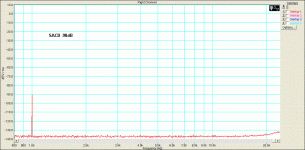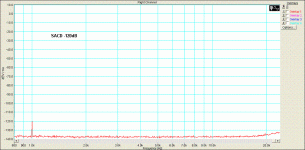john curl said:Demian, I must agree that the spec sheets show improvements in analog magnetic tape of more than I was aware of. It doesn't make sense to me, but I applaud progress.
However the distortion on tape is always fairly high, and the same is true with phono cartridges.
The only redeeming virtue of either system is that the distortion falls in a reasonably predictable way with lower levels, so that LOW LEVEL information is reproduced with great fidelity. I can't say the same for digital.
Huh!
Attachments
Re: For PMA
Neat! Scott, I know you used this in the 797, the technique is described in your (1990?) AES paper.
Is this used in other products that you know of?
Jan Didden
Jan Didden
scott wurcer said:I cooked up this little demo of the crossover distortion removal (797) applied to a fairly ordinary amplifier architecture, the only difference being the differential ”chasing its own tail” VAS. BTW with some work this would make a nice little discrete op-amp even without the error correction.
Because this is a two stage amp, the trick involves a unity gain buffer in addition to the cap. The simulation results show three plots. The amplifier is in a gain of 100 with +-100mA at 10kHz being shoved into the output. The orange plot is with G = 0 on the buffer (little triangle in schematic) and shows the glitch due to the crossover (PMA, sort of looks like your “other guys” plot?). The white plot is with G = -1 showing virtually perfect cancellation. The green plot is with G = +1, horrors positive feedback? No because it’s not feedback, the error is just doubled. In fact if you break the loop at “B” you will see that there is no loop gain (in fact huge attenuation). The little triangle is indeed just a gain of -1 buffer and this is just subtractive neutralization. In all three sims the displacement current in the comp cap (C12) contains the same distortion signal, but at G = -1 it is cancelled exactly by subtraction.
Neat! Scott, I know you used this in the 797, the technique is described in your (1990?) AES paper.
Is this used in other products that you know of?
Jan Didden
Jan Didden
john curl said:Oh, SACD is perfect. Wow! However, at my place, records still sound better. Go figure.
Really? 😀
To me not. Especially not the classical music - great orchestra and big difference in dynamics.
Re: Re: For PMA
No, everyone wants rail to rail amps these days and this uses a lot of headroom to work best. A Hafler 220 mod with this might be fun at the next BA, I don't count on finding the time.
janneman said:
Neat! Scott, I know you used this in the 797, the technique is described in your (1990?) AES paper.
Is this used in other products that you know of?
Jan Didden
Jan Didden
No, everyone wants rail to rail amps these days and this uses a lot of headroom to work best. A Hafler 220 mod with this might be fun at the next BA, I don't count on finding the time.
Scott, why don't you start with a really good discrete op amp topology and then add your distortion improver? Why start with something that looks like it is from the '60's?
I know that you disagree with me, but LOW DISTORTION is not everything. I wish that it was. Even the best audio sources have some significant distortion and speakers have plenty. Therefore, adding an extra decimal point to the distortion spec. of an op amp doesn't really change the sound much, if any.
I know that it is fun to make a 'silk purse' from a 'sow's ear'. That is the normal engineering thing to do, but putting a supercharger on a Yugo, will not make it a Porsche.
I know that you disagree with me, but LOW DISTORTION is not everything. I wish that it was. Even the best audio sources have some significant distortion and speakers have plenty. Therefore, adding an extra decimal point to the distortion spec. of an op amp doesn't really change the sound much, if any.
I know that it is fun to make a 'silk purse' from a 'sow's ear'. That is the normal engineering thing to do, but putting a supercharger on a Yugo, will not make it a Porsche.
Re: Re: Re: For PMA
Aha! You let it out! No way turning back now 😉
Jan Didden
scott wurcer said:
No, everyone wants rail to rail amps these days and this uses a lot of headroom to work best. A Hafler 220 mod with this might be fun at the next BA, I don't count on finding the time.
Aha! You let it out! No way turning back now 😉
Jan Didden
Scott is right. Low supply voltage and low power consumption is asked for. We are a niche 😀
In plasma spraying, MLCC I am required for 😉
In plasma spraying, MLCC I am required for 😉
john curl said:You hire someone to do it. They can work at a reduced wage. They could test perhaps 1000 per day and it might take 2 years.
But if there was a sticker on the amp that the transistors had
been hand-selected by Vietnamese kids and not by the maestro
himself, it would probably loose big time in non-blind tests.
Sorry, couldn't resist.
Gerhard
Most Parasound and early Mark Levinson JC-1 and JC-2 components were measured in this way, by a specially hired 'Asian' person.
Its the transistors that need to be selected in double blind tests. Production line abx. A full employment program. Then we won't need a double blind testing for the finished product. . .
john curl said:Oh, SACD is perfect. Wow! However, at my place, records still sound better. Go figure.
Hi John,
I think records sound better to some people because of the different way in which they are typically mastered. This is a subjective thing, so different people will react differently.
The mastering of a record must take into account a host of limitations of the LP medium. Groove amplitude, velocity and acceleration must all be controlled with limiting, compression or careful gain-riding.
Moreover, some of the results of these actions, like limiting, will subsequently be softened by the RIAA equalization at the far end.
All of this can tend to soften and smooth the sound of an LP. This is not necessarily a bad thing, even though technically it is a departure from transparency.
The digital media does not have as much limitation in regard to the equivalants of groove velocity and acceleration, so some of that mastering activity that may have softened the sound and made things more forgiving may not be there.
This all is why it actually makes sense that Michael Fremer rips LP cuts to CD to demonstrate the LP sound.
Cheers,
Bob
john curl said:Scott, why don't you start with a really good discrete op amp topology and then add your distortion improver? Why start with something that looks like it is from the '60's?
I know that you disagree with me, but LOW DISTORTION is not everything. I wish that it was. Even the best audio sources have some significant distortion and speakers have plenty. Therefore, adding an extra decimal point to the distortion spec. of an op amp doesn't really change the sound much, if any.
I know that it is fun to make a 'silk purse' from a 'sow's ear'. That is the normal engineering thing to do, but putting a supercharger on a Yugo, will not make it a Porsche.
But John you yourself have said that keeping 7th on up very low is important. Wouldn't you agree that this technique is useful if it reduces the high-order products?
Cheers,
Bob
john curl said:Scott, why don't you start with a really good discrete op amp topology and then add your distortion improver? Why start with something that looks like it is from the '60's?
John, this was just a demonstration of a principle. Most of those discrete op-amps everyone raves about are no different (diff-in, VAS, and class A/B out) anyway. Take the JE990, cute trick with inductors in the input (Pease did it at Philbrick BTW) not much else special that wasn't in everyone's modular op-amps of the 60's and 70's.
1audio said:Its the transistors that need to be selected in double blind tests. Production line abx. A full employment program. Then we won't need a double blind testing for the finished product. . .
They are. The machine is called wafer tester. Sorry, nearly no employment.
The need for blind testing (I didn't ask for double) is only because of the sticker.
Gerhard, I don't think that you understand the whole equation. First, it isn't just the wafer that needs to be tested, but each individual device. Only 1 device in 1000 will probably give nearly perfect results, almost entirely by random chance. This is my point. Once we OWN the fets, we can ONLY test them by hand. I am attempting to point out the absurdity of stating an IDEAL spec, when it is almost impossible to reach it.
- Status
- Not open for further replies.
- Home
- Amplifiers
- Solid State
- John Curl's Blowtorch preamplifier

